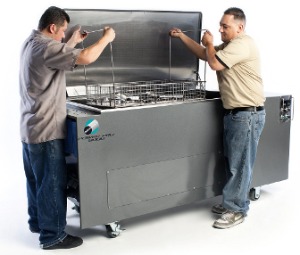Two Approaches to Ultrasonic Degreasing
Ultrasonic cleaning is an excellent method to remove grease and other oily deposits on newly fabricated and refurbished metal parts. Two types of ultrasonic cleaning solutions – emulsifying and demulsifying (or non- emulsifying) – are commonly used for removing such deposits. Let’s look at these two options.
Emulsifying cleaning solutions collect oily contaminants in a mixture or an emulsion of the water-based cleaning solution and the oil. While cleaning is initially thorough continued operation of the cleaning bath causes a build-up of contaminants in the solution. This eventually reduces cleaning effectiveness.
Moreover, when products are removed from the bath they may carry this contamination into the rinsing cycle. Because of this carry out it is important that the parts are thoroughly rinsed to remove remaining emulsified oil. More than one rinsing cycle may be required.
Elma clean 210 is an example of an emulsifying cleaner that is a good choice for steel, non-ferrous heavy metals, light metals and alloys to remove aqueous cooling lubricants, grease, oil, grinding media and polishing pastes.
Demulsifying cleaning solutions work by separating the oil contaminants from the product and allowing them to float to the surface where they can be skimmed off and either properly disposed of or, if they have value, recycled.
An example of a demulsifying cleaner is elma tec clean A4, a universally applicable cleaning concentrate for the lab and workshop to remove oil, grease, combustion residues, soot and other organic contamination.
Handling Removed Contaminants
Operators of high capacity ultrasonic cleaning equipment make significant investments in cleaning solution chemistry. It makes good sense to preserve to the extent practical the effectiveness of the solution. Buildup of contaminants in emulsifying baths can be controlled by passing the solution through oil separators – a process that not only prolongs solution life but also lowers the consumption of water, chemicals and energy.
The effectiveness of demulsifying solutions can be greatly extended by specifying cleaners equipped with a skimming ledge such as found on the Elmasonic X-tra Line. Oil skimmers and spray bars direct the floating oil to a separate section of the tank. From there it can either be recycled or disposed of in a proper manner.
Cleaning solution life and the useful life of the ultrasonic cleaner are extended when units are equipped with filtering systems to remove most of the contaminants thereby allowing the solution to be used longer before it is drained and replaced. Filtration systems also help remove coarse contaminants that otherwise fall to the bottom and, if left there can eventually damage the tank. Note that even with a filtering system ultrasonic cleaner tanks should be drained and cleaned with water on a regular basis.
For more information on this topic see our post on skimmers and filters.
Talk to the ultrasonic cleaning professionals at Tovatech for sound advice on selecting the correct cleaning solution chemistry and solution maintenance procedures best-suited to your individual requirements.

